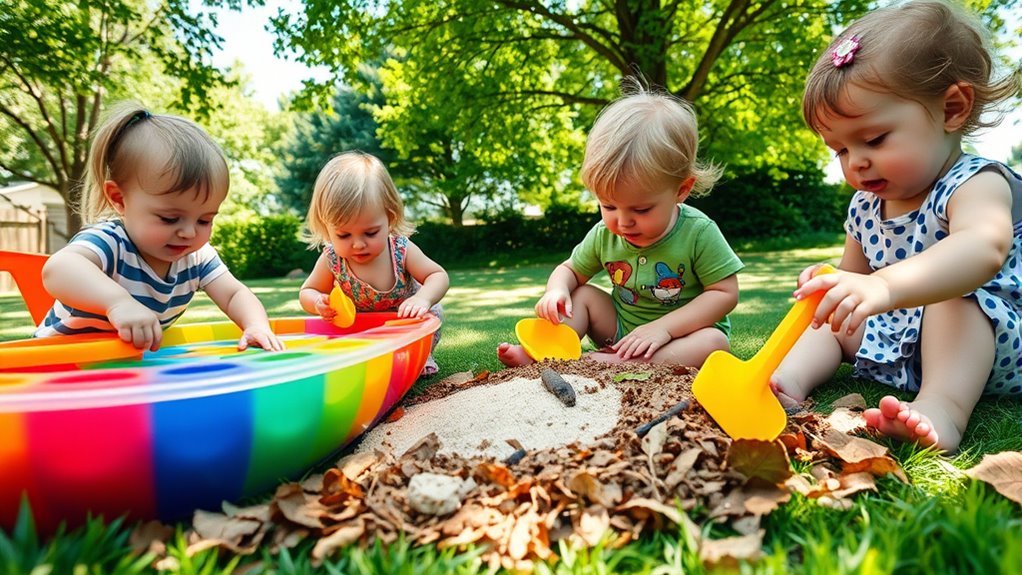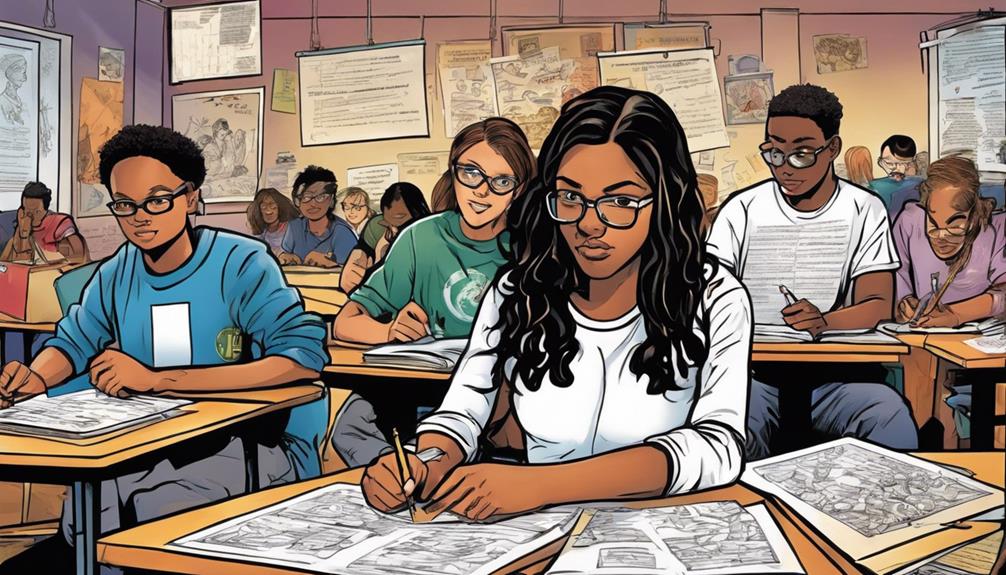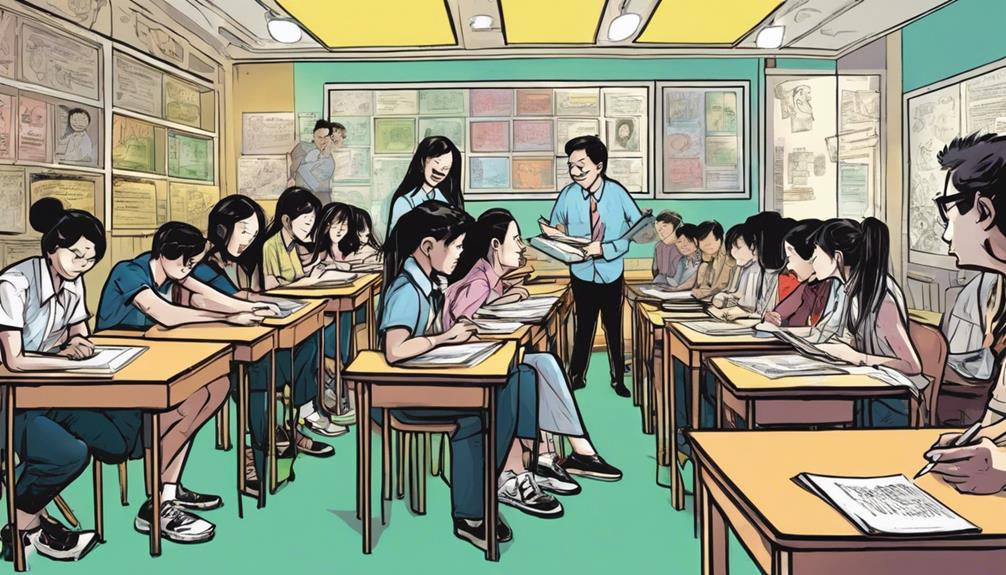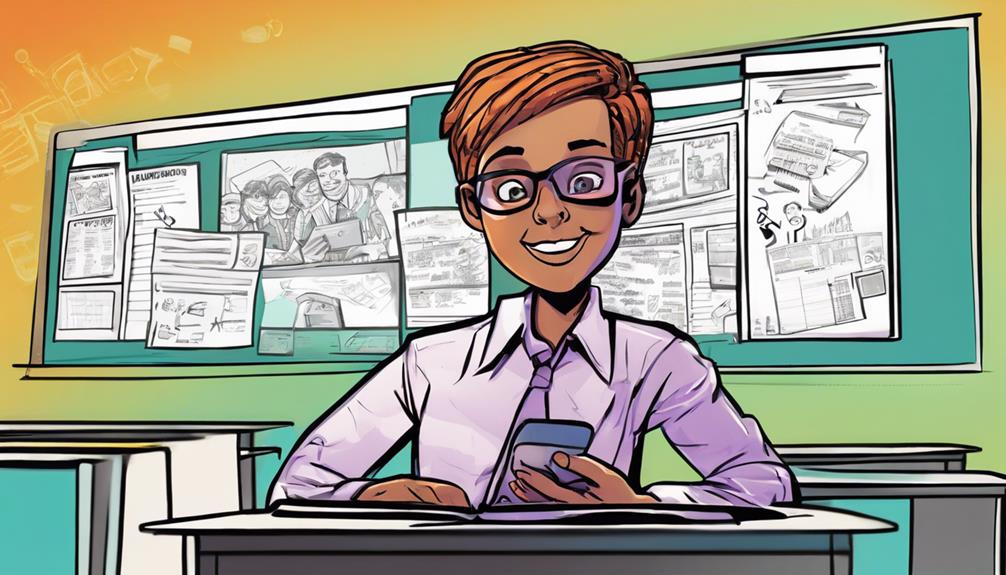To keep your toddler engaged outdoors, try activities like a nature treasure hunt to enhance sensory skills, leaf and flower rubbings for tactile fun, and exploring a sensory bin filled with natural materials. Water, sand, and mud play boost creativity and motor skills, while creating a sensory path with different textures adds movement and exploration. Playing musical instruments made from natural items also sparks their auditory senses. Keep exploring more ideas to make outdoor play both fun and developmental.
Key Takeaways
- Incorporate nature treasure hunts and leaf/ribbon rubbings to stimulate tactile and visual senses.
- Use sensory bins with natural materials like sand, shells, and stones for hands-on exploration.
- Set up water play areas with sprinklers, boats, and water tables to promote motor skills and sensory engagement.
- Create sensory paths with varied textures, movement challenges, and natural elements for active sensory development.
- Include outdoor musical instruments made from recycled materials to develop auditory skills and encourage creative play.
Nature Treasure Hunt
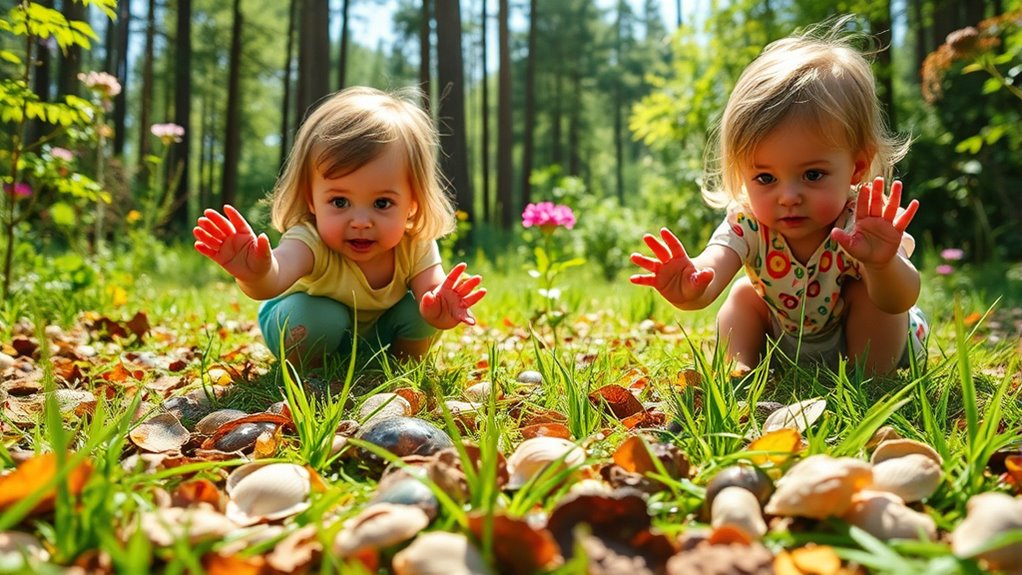
A nature treasure hunt is a fun way to engage toddlers with their outdoor environment while developing their sensory skills. As you lead them, encourage wildflower spotting—point out colorful blooms and let your child feel the different textures. This sharpens their visual and tactile senses. You can also incorporate insect observation by guiding them to gently watch bees, butterflies, or beetles. Ask questions about what they see and hear, fostering curiosity and attention to detail. Keep the activity lively by moving around different areas, and provide simple clues or pictures to help your toddler find specific treasures. Incorporating regionally available resources and data-driven strategies into your activity can help tailor the experience to your child’s interests and developmental stage. This interactive exploration boosts their sensory awareness, observation skills, and appreciation for nature—all while having a joyful, engaging experience outdoors. Additionally, using sensory-rich materials like textured fabrics or natural objects can further enhance their engagement and learning during the activity. Incorporating nature-based learning techniques can also deepen their connection with the environment and promote curiosity.
Sensory Bin Exploration
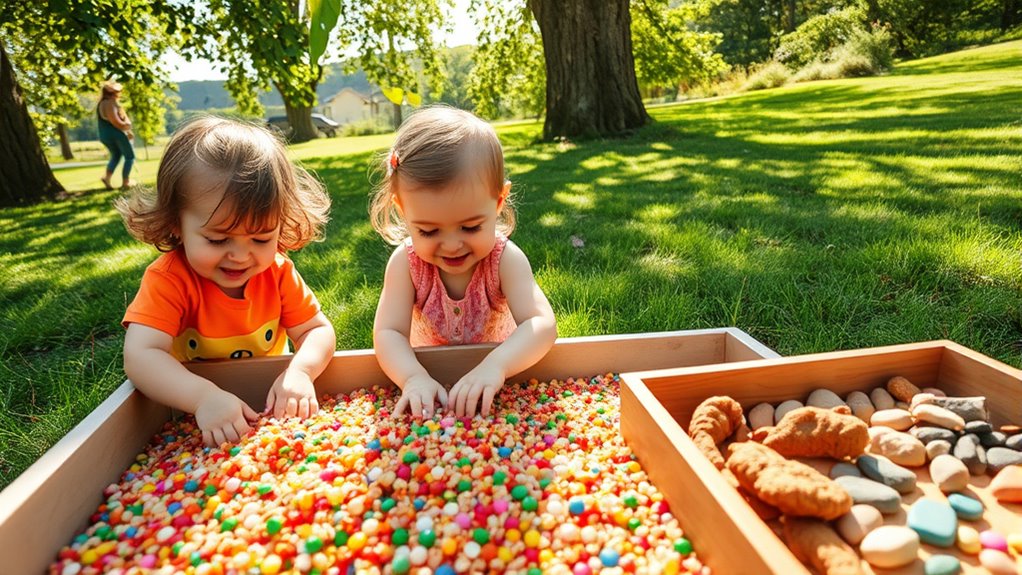
After exploring the outdoor environment through a treasure hunt, you can bring the sensory experience closer to home with a sensory bin exploration. Set up a designated space with a well-organized sensory bin, making it easy for your toddler to access and explore. Use simple DIY sensory bin ideas like rice, pasta, or sand, and add items such as shells, stones, or small toys for variety. Keep the bin organized with clear labels or separate compartments to encourage independent play and learning. Here’s a visual to inspire your setup:
| Sensory Bin Contents | Exploration Focus |
|---|---|
| Colored rice | Fine motor skills |
| Water beads | Sensory stimulation |
| Shells and stones | Texture exploration |
| Small toys | Imaginative play |
Creating a variety of textures and materials in the sensory bin can also support sensory development, helping your toddler build new skills in a fun, accessible way. Incorporating different materials can stimulate various sensory pathways, promoting overall growth and coordination. Additionally, engaging with diverse textures can foster emotional regulation, contributing to your child’s overall well-being. Using a variety of materials in the sensory bin can also enhance multisensory learning, which is crucial for comprehensive development. Moreover, exposing children to different textures can help develop their tactile discrimination, further supporting their sensory processing skills.
Water Play Adventures
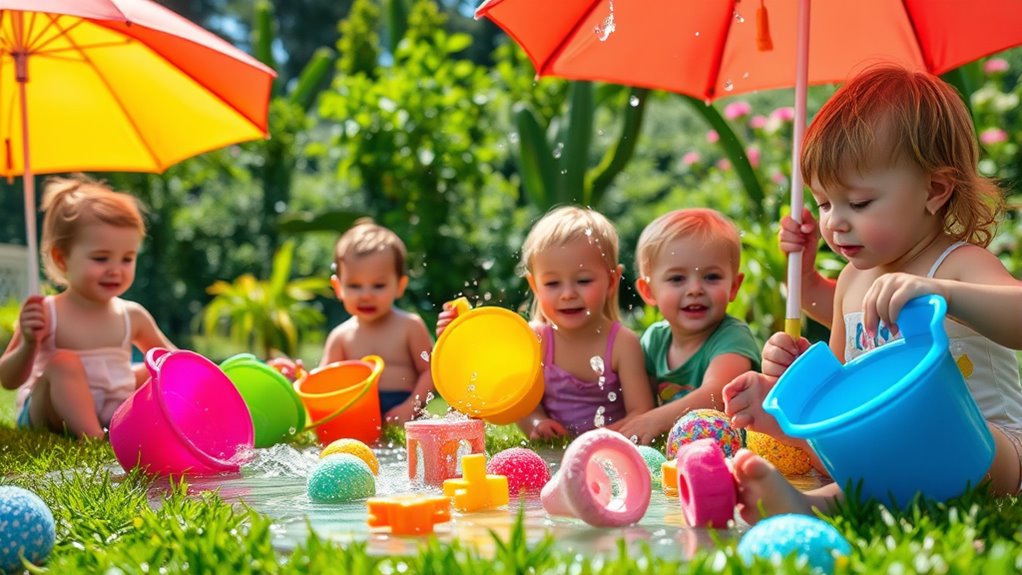
Water play adventures offer a delightful way to engage toddlers’ senses and develop their motor skills outdoors. As they splash water around, they strengthen their hand-eye coordination and learn about cause and effect. Set up a shallow tub or a sprinkler to encourage water splashing, which excites their senses and promotes active play. You can also organize simple boat racing activities, where toddlers race lightweight boats across a small pool or water table. Watching the boats glide and competing to see which ones move fastest enhances their observational skills and introduces basic concepts of speed and direction. These activities not only entertain but also help toddlers improve their coordination, balance, and sensory awareness, making water play adventures both fun and educational. Incorporating safety precautions ensures that water play remains a secure and enjoyable experience for little ones.
Sand and Mud Play
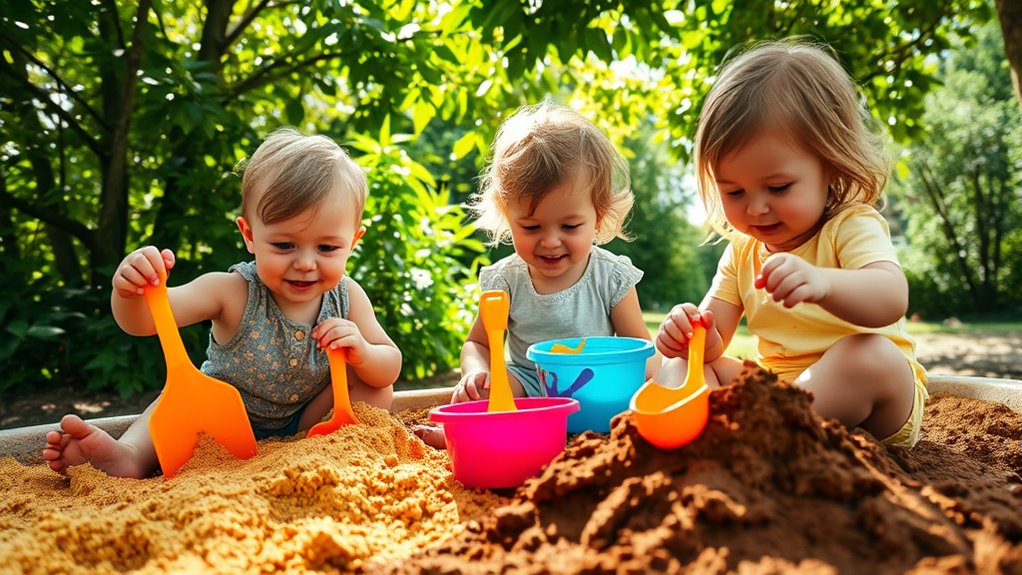
Sand and mud play let your toddler build creative structures and explore textures firsthand. These activities boost sensory development and encourage imaginative thinking. Just remember to follow safe play guidelines to keep the experience fun and risk-free. Incorporating natural materials like sand and mud can also promote environmentally friendly play, aligning with sustainable practices. Using diverse materials can enhance the sensory experience and support eco-conscious play. Additionally, selecting materials that are non-toxic and safe ensures your child’s safety during playtime. Choosing materials with appropriate durability further ensures they withstand active use and rough handling by energetic toddlers. Being aware of local regulations about natural material collection ensures that your play remains environmentally responsible.
Building Creative Structures
Building creative structures with sand and mud offers toddlers a wonderful opportunity to explore their imaginations while developing their fine motor skills. As they experiment with imaginative architecture, they learn to design and build unique formations, fostering their creativity. This activity also introduces basic concepts of structural engineering, as they figure out how to balance and support their creations. You can encourage your toddler to build castles, tunnels, or bridges, inspiring them to think critically about stability and design. Using hands-on manipulation, toddlers strengthen their hand-eye coordination and dexterity. Providing simple tools like buckets and shovels enhances their building experience. Engaging in sand and mud play not only sparks their imagination but also supports their cognitive and physical development in a fun, natural setting. Incorporating safe and secure play environments ensures that children can explore freely while minimizing risks. Additionally, understanding child development principles can help tailor activities that support their growth effectively. Moreover, incorporating sensory exploration into play can further enhance their engagement and learning outcomes. Including a variety of textures and materials can also promote multisensory learning experiences, enriching their development through diverse tactile input.
Sensory Exploration Benefits
Engaging in sensory exploration through sand and mud play offers toddlers a rich, hands-on experience that enhances their understanding of the world around them. This type of play markedly boosts sensory development by stimulating touch, sight, and even smell. As you watch your child manipulate sand and mud, you’ll notice improvements in their fine motor skills and hand-eye coordination. The cognitive benefits are equally impressive; they learn about textures, cause-and-effect, and spatial relationships through active exploration. Sand and mud play encourages curiosity and problem-solving, helping toddlers develop critical thinking skills. Additionally, participating in water-based activities can further enrich their sensory experiences. Incorporating the use of electric bike conversion kits in outdoor activities can also promote physical activity and environmental awareness. Overall, this sensory activity fosters a deeper connection with their environment while supporting essential developmental milestones in a fun and engaging way.
Safe Play Guidelines
To guarantee safe and enjoyable sand and mud play, it’s important to establish clear guidelines that protect your toddler’s health and well-being. First, always use age-appropriate gear, such as non-toxic buckets and shovels, to prevent choking hazards. Second, supervise your child closely, applying effective supervision strategies to monitor their activity and prevent ingestion of dirt or debris. Third, check the play area for hazards like sharp objects or animal waste before play begins. Finally, encourage handwashing immediately after play to remove germs and dirt. These simple steps help create a safe environment where your toddler can explore and enjoy sensory activities confidently, fostering curiosity while minimizing risks.
Leaf and Flower Rubbings
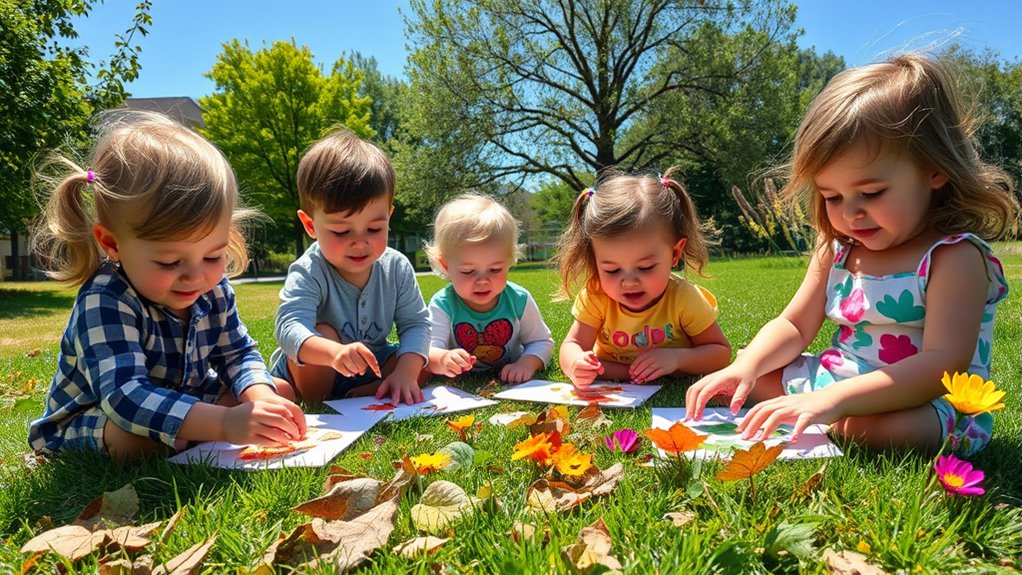
Choosing textured leaves and flowers is your first step to engaging sensory play, so pick varieties with interesting veins and surfaces. Use different rubbing techniques and tools, like crayons or charcoal, to create varied patterns. Once finished, get creative by displaying the rubbings as art or incorporating them into crafts to inspire your toddler’s imagination.
Selecting Textured Leaves and Flowers
Selecting textured leaves and flowers for rubbings involves observing their unique surfaces and patterns. You want to choose leaves with prominent veins or ridges and flowers that offer interesting textures. When selecting textured leaves, look for variety—some are smooth, others rough or crinkled. Choosing fragrant flowers adds a sensory layer that excites your child’s sense of smell and enhances engagement. Here are some tips to make your selection meaningful:
- Pick leaves with bold, visible veins to create striking rubbings.
- Select flowers with varied petal textures for tactile exploration.
- Opt for fragrant flowers to introduce scent into the activity.
- Gather a mix of smooth and rough textures for a rich sensory experience.
This thoughtful selection makes the activity more stimulating and memorable.
Rubbing Techniques and Tools
Using the right rubbing techniques and tools can make your toddler’s sensory experience more engaging and effective. Focus on gentle, consistent pressure to help with texture identification, allowing your child to feel the subtle differences in leaves and flowers. Choosing appropriate rubbing tools is essential; soft crayons, side of chalk, or textured sponges work well. These tools help toddlers explore various textures without tearing the paper or damaging the surface. Encourage them to experiment with different pressures and angles to discover how textures change with each stroke. To organize your supplies, consider this table:
| Rubbing Tool | Suitable Surfaces |
|---|---|
| Soft crayons | Flat leaves, smooth flowers |
| Side of chalk | Textured bark, veined leaves |
| Textured sponges | Bumpy flowers, rough bark |
This approach enhances texture identification and keeps play safe and fun.
Creative Display Ideas
Once your toddler has explored textures through rubbing techniques, turning these creations into beautiful displays can make their efforts even more rewarding. You can create a charming garden decor by framing leaf and flower rubbings and hanging them outdoors. Consider weather conditions—plastic sleeves or laminated pieces protect art from rain and sun damage. Here are some creative display ideas:
- Attach rubbings to a trellis or fence for a colorful garden border.
- Use clips or washi tape to display on a patio or porch wall.
- Mount on a sturdy board to craft a nature-inspired collage.
- Laminate and turn into weather-resistant placemats for outdoor mealtime.
These ideas celebrate your toddler’s sensory discoveries and add a personal touch to your outdoor space.
Outdoor Musical Instruments
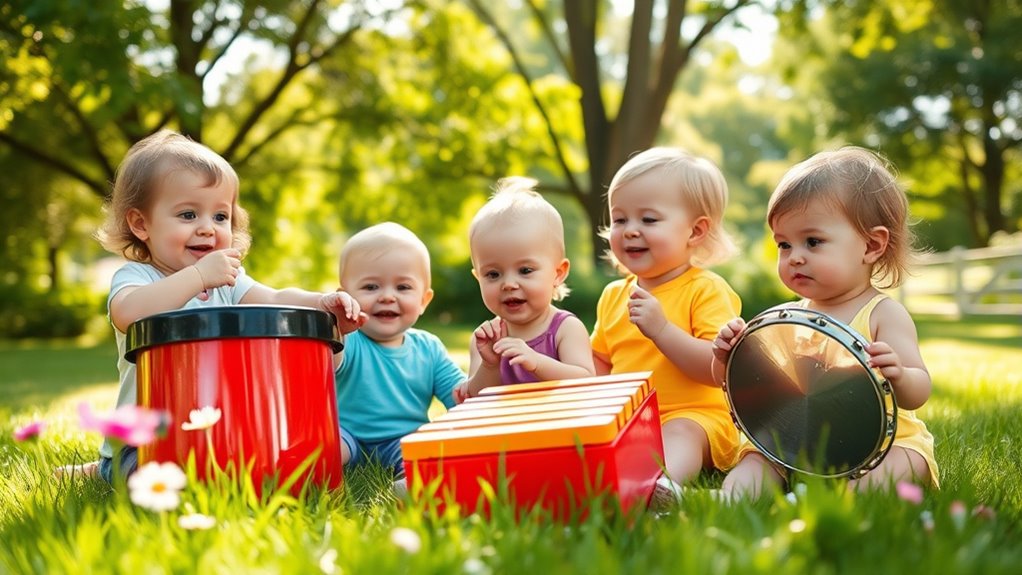
Outdoor musical instruments transform any play area into a lively, engaging space where toddlers can explore sound and rhythm. You can encourage musical instrument crafting by guiding children to create their own instruments from natural or recycled materials, like drumsticks from sticks or shakers from bottles filled with beans. These DIY projects spark creativity and make outdoor rhythm activities more personal and exciting. When kids experiment with different sounds and beats, they develop their auditory skills and sense of timing. Incorporate simple instruments like xylophones, drums, or tambourines to enhance their musical experience. Playing together fosters social interaction and teamwork, making the outdoor space both fun and educational. This approach turns outdoor play into a vibrant, musical adventure tailored for toddlers.
Sensory Path Creation
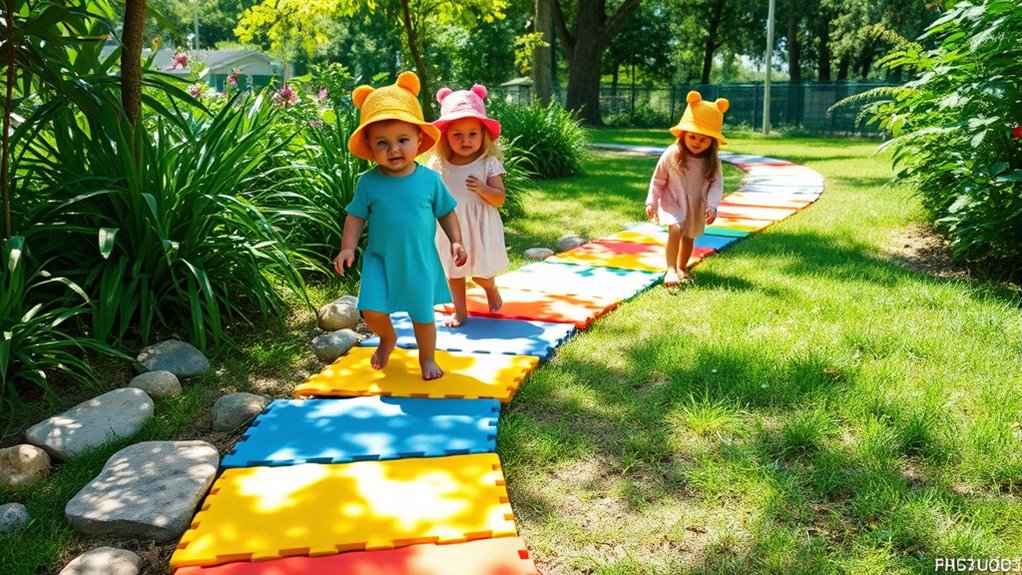
Creating a sensory path in an outdoor space offers toddlers a dynamic way to explore different textures, colors, and sensations through movement. When designing your sensory path layout, think about how each section can engage their senses and encourage active play. Carefully select tactile surfaces that are safe and stimulating, like smooth stones, soft moss, or rough bark. Incorporate variety to evoke curiosity and joy:
- Use colorful stepping stones for visual excitement.
- Add textured mats for tactile exploration.
- Incorporate natural elements like sand or pebbles.
- Include gentle slopes or balance beams for movement challenge.
This approach ensures your sensory path becomes a fascinating, safe environment that promotes development and discovery through sensory-rich experiences.
Bubble Blowing Fun
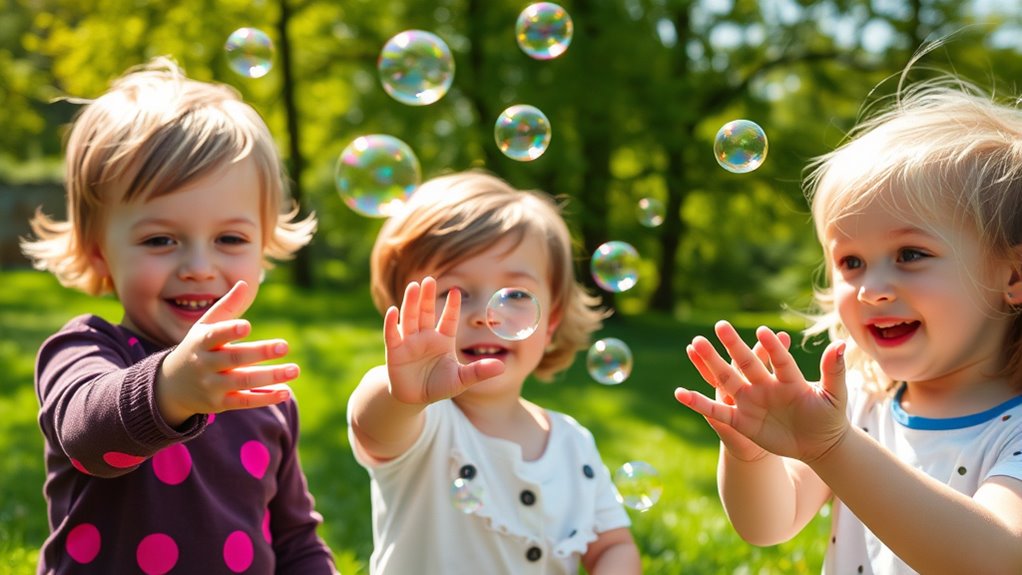
Bubble blowing is a simple yet exciting outdoor activity that captivates toddlers and encourages active engagement. As you teach your little one about bubble chemistry, you’ll see their curiosity grow through blowing techniques like gentle puffs or big breaths. Experimenting with different methods creates a fun learning experience. For added interest, try using wands, straws, or homemade tools to create unique bubbles.
| Bubble Chemistry Ideas | Blowing Techniques |
|---|---|
| Combine soap with glycerin for longer-lasting bubbles | Use slow, steady breaths for larger bubbles |
| Add food coloring for colorful bubbles | Puff quickly for small, energetic bubbles |
| Mix bubble solutions with water for variety | Vary your blowing distance for different sizes |
Shadow and Light Play
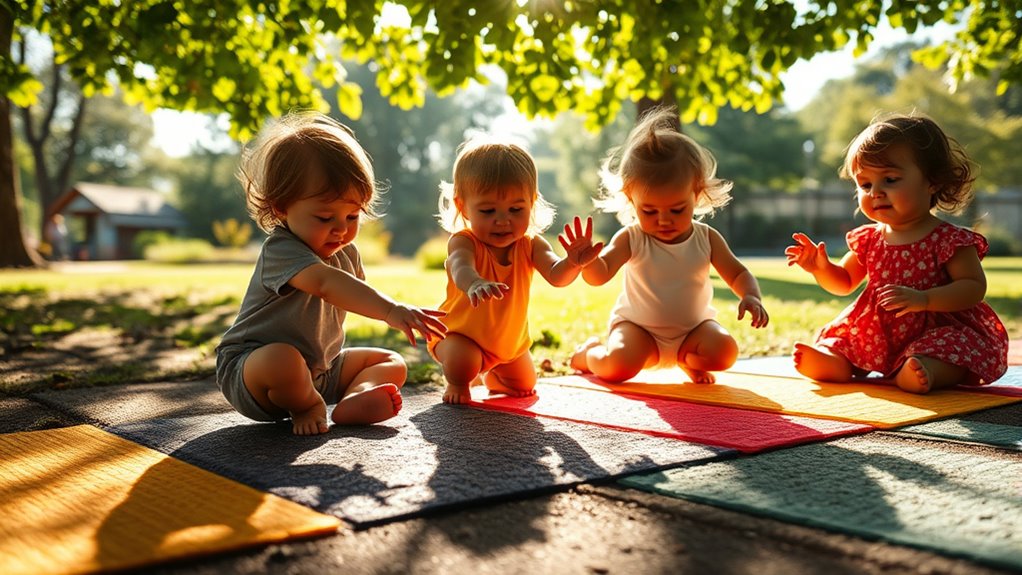
Have you ever noticed how shadows dance and change shape as the sun moves? These fleeting shapes captivate your toddler’s curiosity and spark their imagination. You can create magic with simple activities like shadow puppets, encouraging your little one to mimic animals or characters. Play with light refraction by using a glass of water to bend sunlight, revealing colorful patterns on the ground. Here are some ideas to explore:
- Make shadow puppets on a sunny wall, telling stories with hand shapes
- Use a flashlight at dusk for more dramatic shadow creations
- Introduce light refraction by shining through crystal or glass objects
- Encourage your toddler to observe how shadows shift when you move around
These activities develop their sensory awareness while fostering creativity and wonder.
Frequently Asked Questions
How Can Outdoor Sensory Activities Support a Child’s Developmental Milestones?
Outdoor sensory activities help your child reach developmental milestones by enhancing sensory integration and motor development. As you encourage them to explore different textures, sounds, and smells, they improve their ability to process sensory information effectively. These activities also promote motor skills like crawling, walking, and hand-eye coordination. By engaging in outdoor sensory play, you support your child’s overall growth, building a strong foundation for future learning and development.
What Safety Precautions Should Parents Take During Outdoor Sensory Play?
Did you know that 65% of outdoor accidents involve a lack of supervision? To keep your toddler safe during sensory play, always follow supervision guidelines, watching them closely. Identify hazards like sharp objects, uneven ground, or toxic plants beforehand. Keep a first aid kit nearby and guarantee play areas are secure. By staying vigilant and proactive, you create a safe environment that encourages exploration and learning.
How Do Outdoor Sensory Activities Benefit Children With Special Needs?
You’ll find outdoor sensory activities benefit children with special needs by enhancing sensory integration, helping them process different stimuli more effectively. These activities also support emotional regulation, allowing kids to manage their feelings better through calming, engaging experiences. By providing varied textures, sounds, and sights, you help children develop essential skills, boosting confidence and independence. Outdoor sensory play creates a supportive environment where children can explore safely and grow at their own pace.
Are There Age-Appropriate Modifications for Toddlers in Sensory Play?
You can make sensory play more toddler-friendly by incorporating age-appropriate modifications and sensory play adaptations. Use soft textures, gentle sounds, and simple activities to guarantee safety and engagement. Keep activities short and supervised, and choose materials that are non-toxic and easy to handle. These toddler-friendly modifications help your little one explore their senses comfortably while supporting their development and ensuring they stay safe during play.
How Can Parents Encourage Extended Outdoor Sensory Play Sessions?
Imagine a parent setting up a backyard with different textures like sand, water, and leaves. To encourage extended outdoor exploration, you can create a sensory-rich environment by rotating various natural materials and incorporating engaging activities. Consistently joining your child in outdoor play, offering new challenges, and praising curiosity motivate longer sessions. Your involvement turns outdoor exploration into a fun, educational experience that boosts your toddler’s sensory development and love for nature.
Conclusion
As you guide your little ones through these outdoor sensory adventures, watch their imaginations bloom like a garden in full sun. Each activity becomes a vibrant brushstroke on their growing canvas, painting memories that shimmer like dew drops in the morning light. With every touch, sound, and discovery, you’re opening a doorway to wonder and curiosity. So, step outside and let nature’s palette turn your backyard into a lively, magical playground where tiny explorers thrive.

